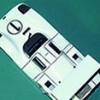I was therefore wondering how WR got around those rule at Le Mans from 1993 to 1996 with their single seat LM93, the only possible explanation being that as a French team they were exempt from the normal rules that the ACO applied to all other nationalities !
I haven't of the top of my head found any other cars in the history of Le Mans, classic or modern, that had an F1 style single seat appearance. Were there others ?






























